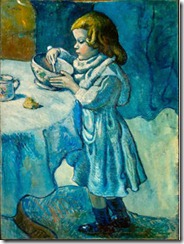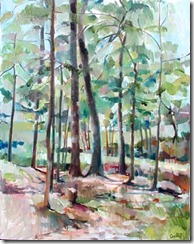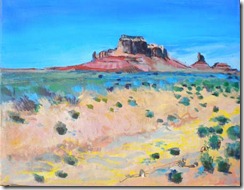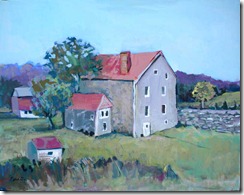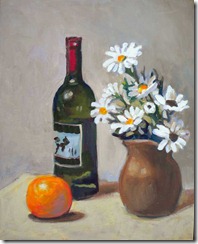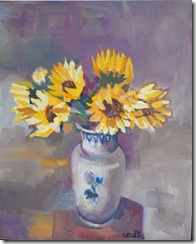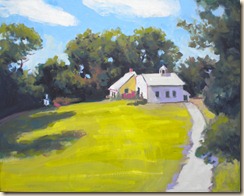Tuesday, March 30, 2010
What is Fauve?
In 2008, when I was part of a short-lived group called Max-21, I did an experimental self portrait which I titled "Self-Portrait, Fauve." It's pictured here and you can see a larger version of it on my gallery site. I donated it to the Art League of Alexandria for their annual fund-raiser. I was interested to find that, not only did it sell (not surprising) but also received an Honorable Mention prize. (No money, though, alas!)
Monday, March 29, 2010
What to say?
A visual artist can have writer’s block just like a writer. I’ve certainly experienced this. You can reach a point where you think that there’s nothing more to be said. Maybe, at this point, you should be taking in information. Go to a museum or gallery. Luxuriate in the endless creation that is going on. Come home and pick up a brush or pen or pencil. Don’t worry about perfection. Just practice.
Picasso's Blue period painting Le Gourmet (1901)
Article with video at:
Wednesday, March 24, 2010
Don’t neglect grey
When I was a young artist, still feeling my way around the subject of color and composition, I sometimes wondered why my paintings marched across the surface of the canvas and had little “depth.” It took me a while to discover the importance of the neutrals — probably in part because the art teacher was always harping on not letting your painting get “muddy.”
What’s wrong with mud?
Have you ever noticed that really elegant room designs have mostly subdued colors with one or two color accents used judiciously? That’s not to say that bright, busy compositions don’t have their place (and I remember when, as teenagers, we discovered the use by Mexicans of red, pink, yellow and bright green and blue in fabulous swirling skirts).
But mud has its uses.
A landscape that is all green may be particularly hard to paint. Just too much strong green. But choose well — a field with pale brown stubble, a grey lowering sky, a sparkling river going through it with grey rocks and sandy banks — and you may have something more appealing.
Remember your basic color wheel. The concepts used to mix mud are that the outer ring of the color wheel consists of the pure hues, the rainbow colors. As you mix the three primaries (or any complementary pair) you approach black. Add an little white and you get quantities of mud: greys, browns, ochres, earth reds….
Try it.
The painting pictured above I did years ago. It’s called “Annandale” and was the view from my dining room window. I think it works partly because of the use of neutrals to relieve the strong greens and blues. (Notice the neutrals I used were browns, “warm neutrals” while the blues and greens are cool colors.)
Tuesday, March 23, 2010
Pondering
Ask yourself: what is my purpose as an artist? This is not a serious question. I will allow you to change your answer or come up with several different answers, but do take a moment to think about it. What are you doing as artist? Write it down. Date it. Put it aside where you'll find it later.
I recently met an artist who felt that the all-important thing was finding out what was wanted and producing that. I don’t agree at this point in my career. If I wanted to produce what the public wants, exclusively, I could be a programmer or a short order cook and do it with art.
It’s a little bit like an “almost right item,” an answer that’s close enough to creating what I want that it festers and itches like a hair shirt. This doesn’t mean that I’m right and my friend was wrong. There may be ways that I will develop when I will look back and wonder why I was so stuck on a particular style.
We tend to stick with what we are comfortable, and I have to admit that I’ve never painted a “night scene.” My advice: develop your skill, but try to stretch yourself periodically. And look at what your purpose is as an artist. There may be many answers.
Monday, March 22, 2010
Depth perception
One of the things that makes painting on a flat surface interesting and a challenge is its limitations. You are, in essence, trying to “capture” the attention of the viewer. The illusion of depth is one way to do that. If you can bring the viewer into the canvas and move him visually around the canvas, you have created a sort of depth space. I refer you to my article The Third Dimension for more on depth. The painting I show here, finished this Fall, risks this by a sky just a bit too blue. But I think it works. See if you agree or not and why. It is a view of Monument Valley done from a reference photo. (16 x 20, acrylic, available in my eBay store until April 18th.)
Thursday, March 11, 2010
“Sunday Morning Papers” accepted in Art League of Alexandria show
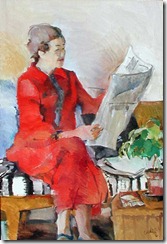 Sunday morning Papers is a lovely painting I did many years ago when I caught my mother reading the Sunday papers in a red robe. I liked the composition so well that I did it all in one sitting. When I had finished, my mother, who was herself an artist, came around and looked at it and said “But I don’t have a nose.” “Too bad,” I replied. “It’s finished!” Some years before that, I had painted a self portrait with green hair. When she protested that my hair wasn’t green, I tried to change it and ruined the picture. Some paintings just take on a life of their own! Anyway, here it is, it’s on display at the Torpedo Factory, Alexandria, VA until April 6, 2010 for $1100 (and worth every penny.) You can see a larger version of it in my web gallery.
Sunday morning Papers is a lovely painting I did many years ago when I caught my mother reading the Sunday papers in a red robe. I liked the composition so well that I did it all in one sitting. When I had finished, my mother, who was herself an artist, came around and looked at it and said “But I don’t have a nose.” “Too bad,” I replied. “It’s finished!” Some years before that, I had painted a self portrait with green hair. When she protested that my hair wasn’t green, I tried to change it and ruined the picture. Some paintings just take on a life of their own! Anyway, here it is, it’s on display at the Torpedo Factory, Alexandria, VA until April 6, 2010 for $1100 (and worth every penny.) You can see a larger version of it in my web gallery.
Recent paintings
I have recently completed several paintings. I’d like to share them with you here. The three paintings which follow are all 16 x 20 and edge painted with wires ready for hanging or framing (if you prefer).
Tuesday, March 09, 2010
Vale Schoolhouse Painting
I've been so busy I've been neglecting to promote. Well, no promotion means no one knows about what I've been doing. So here's a little update:
I continue to teach an "Oil and Acrylics workshop" at the Reston Community Center. The painting shown here was a demo of oil painting completed during a recent class. It's a view of a small schoolhouse called "Vale School" on Vale Road in Oakton, Virginia. It is 16 x 20, the sides are painted (so it can be hung without framing) and it already has wiring on the back.
I will be including this painting in may ebay store. http://stores.ebay.com/Pam-Coulter-Art

